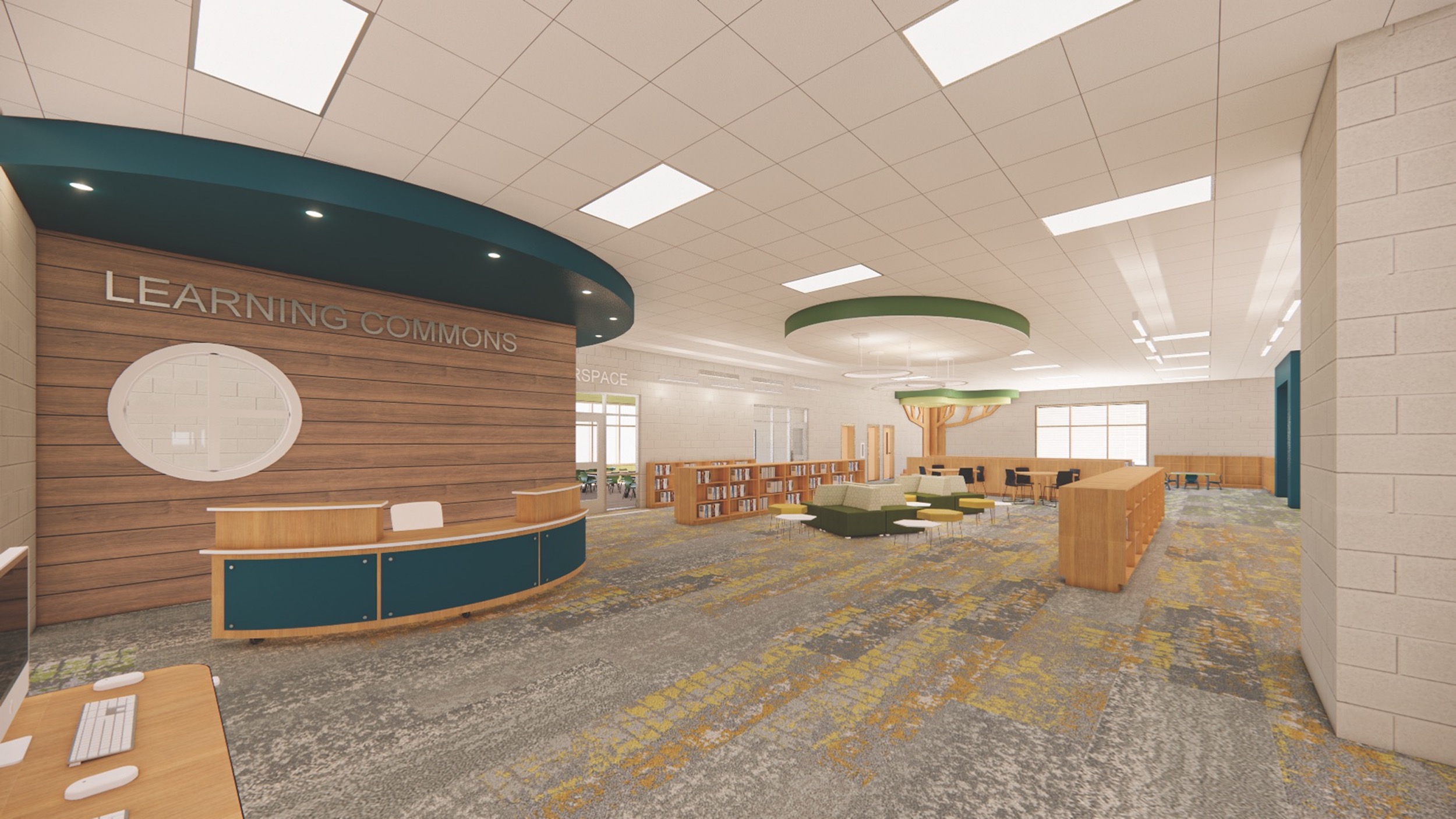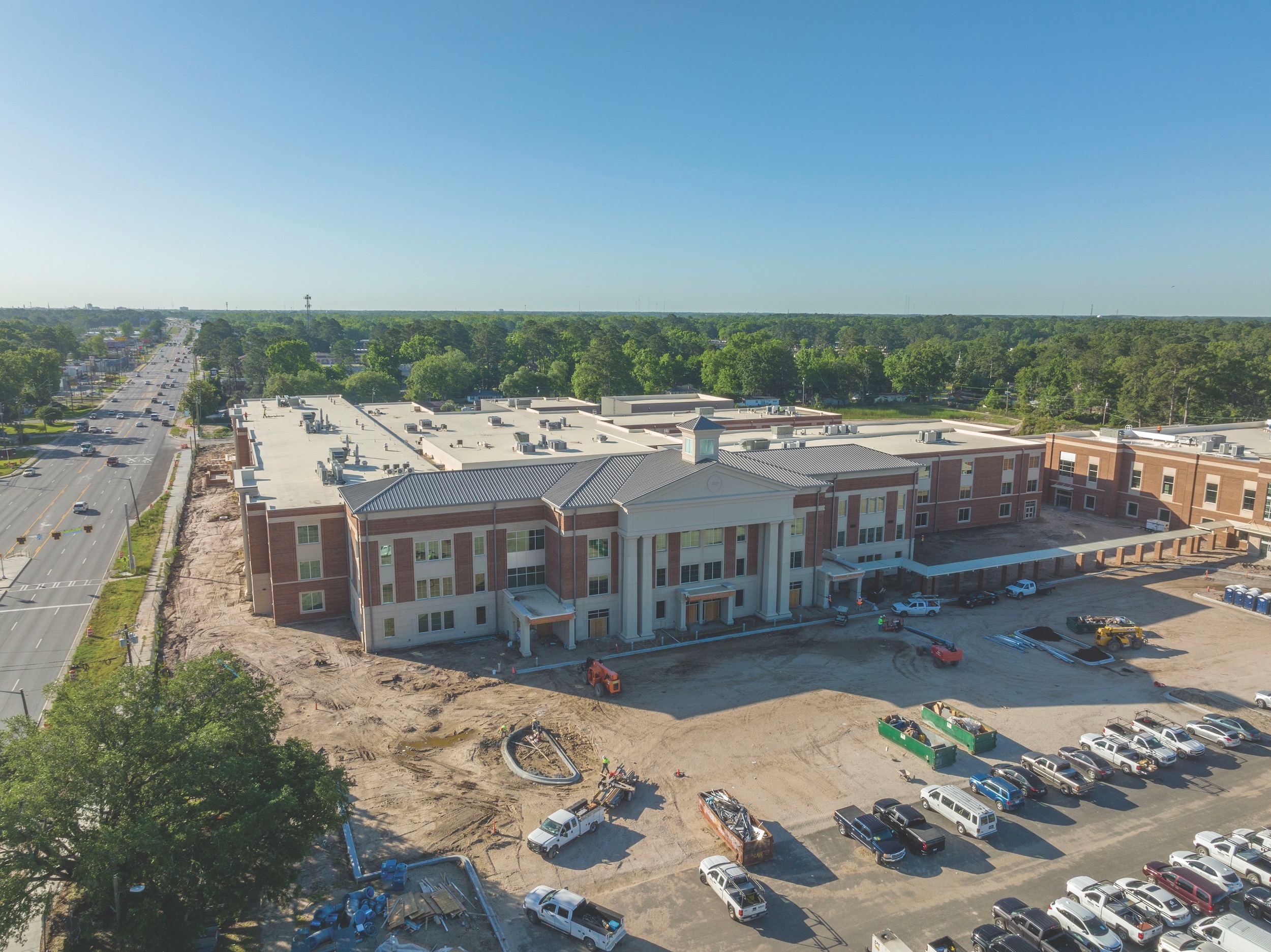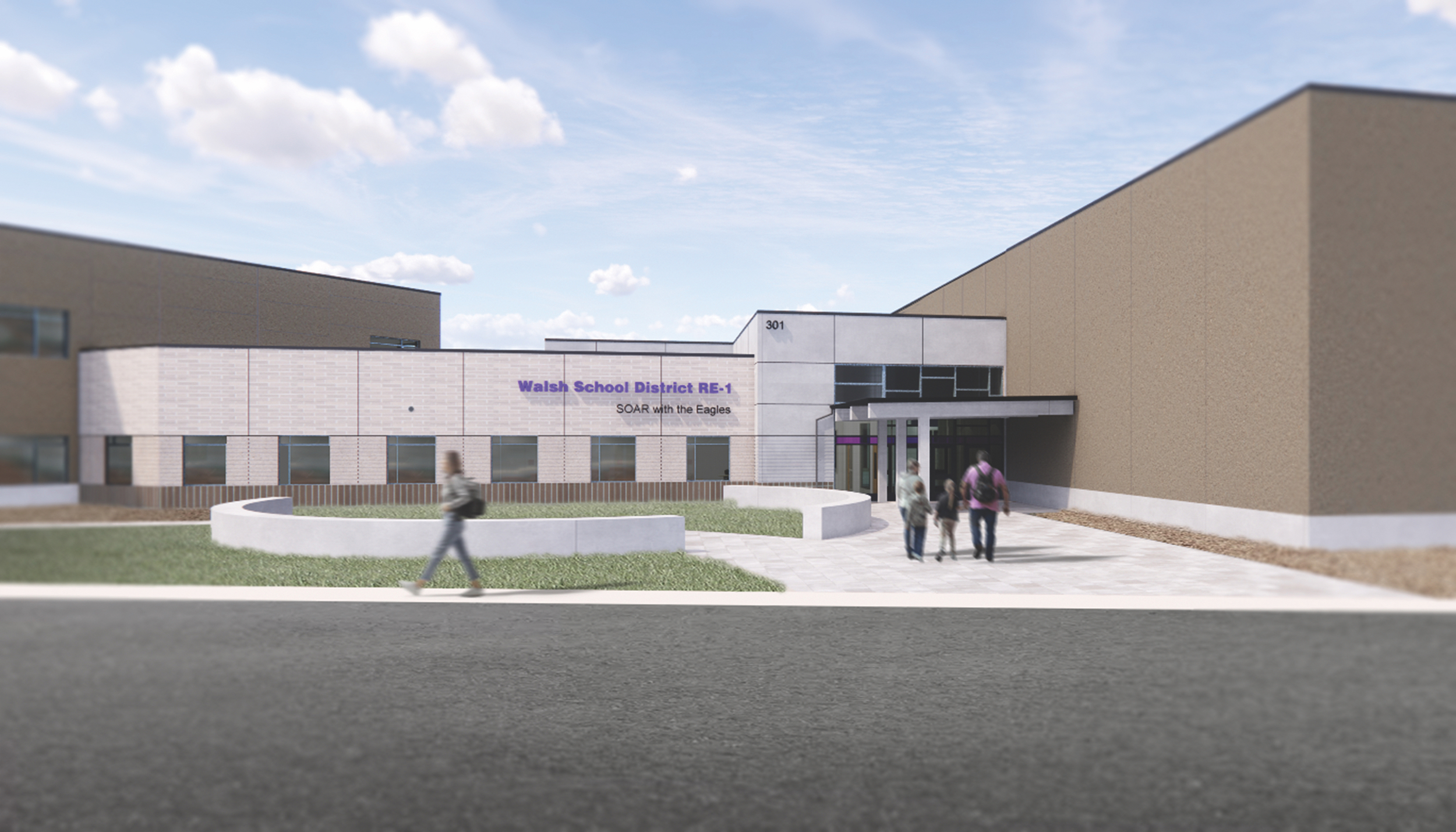In late March, Walsh School District in rural Colorado started construction on a 60,000-sf school that, when completed in the spring of 2024, will teach students in grades Pre-K through 12 under one roof.
In Georgia, the Savannah-Chatham County Public School System (SCCPSS) is wrapping up construction on a 410,000-sf K-12 multi-school project in Garden City, near Savannah, that will enroll about 2,400 students.
While corralling elementary, middle, and high school students in one building isn’t unheard of, it’s still more the exception than the rule, and controversial as news about bullying in schools has become more frequent. “If anything, more schools are separating grade levels,” observes Chris Greer, Henderson Engineers’ K-12 Education Practice Director.
A few years ago, JCJ Architecture designed a one-building K-12 school for a district in Rochester, N.Y. But, says Jim LaPosta, the firm’s Chief Architectural Officer, the prevailing single-building model remains K-8.
However, that could be changing. The general contractor Barton Malow has been working with the Kresge Foundation and the University of Michigan to build PK-16 schools in Detroit. (At least one is under construction, says Mike Stobak, the firm’s Vice President of its K-12 Group.)
The Savannah K-12 school is part of a larger trend toward school building consolidation, in Georgia and other states, asserts David Hamilton, Vice President and Regional Manager for Charles Perry Partners, the general contractor on the Garden City project, whose “all-in” cost is $135 million, according to Dr. Slade Helmly, SCCPSS’s project manager.
Phase 1 of this project, which will be completed this summer, includes two gyms, two cafeterias, and a common kitchen. The school will feature a digital media lab, career and technical education programs for aviation, logistics, and business, a two-story, 750-seat auditorium, and a parking lot with at least 660 spaces. Phase 2 went out for bid in May, says Helmly, and encompasses a fieldhouse and stadium, and campus police department. (The old police station had been on this site, as was Gross High School, both of which were demolished.)
A 50-kW solar array on the new building’s roof will supply one-third of the school’s energy needs.
Addressing security concerns in single-building K-12 schools
Vaughn Dierks, a Partner with Wold Architects & Engineers, which is the Project Architect on the Walsh School District’s PreK-12 school, says that having students of all grades in one building isn’t that big of a deal for this mountain community, where “the kids ride the same bus together, and the older kids look after the younger ones.”
Hamilton thinks that SCCPSS and LS3P Associates—which designed the Garden City school and hired the engineers and contractor for the building team—did a good job separating the lower and upper grades via glass partitions and access-control doors.
April Mundy and Lisa Pinyan, LS3P’s Project Architect and Senior Project Manager/Interior Designer, tell BD+C that their firm designed this campus as three buildings—a primary, middle, and high school—that “share a few common walls.” Administration and student services are strategically located in multiple locations throughout the building, which helps to delineate zones, supervision, and security.


ambitious project as reinforcing the local community. Graphics: LS3P Associates
The idea behind the single-building K-12 school, they explain, is rooted in three basic tenets:
• Improving the educational experience by allowing the administration to adjust classroom grade assignments as enrollment ebbs and flows each year. This environment should also enhance professional development and cross collaboration, and provide more varied learning to students;
• Sharing common core programs and spaces that include specialized arts and performance venues, career education, athletics, and food services; and
• Improving security and operations with centralized systems, so infrastructure can be more efficient by serving a larger student population. Each phase of the building’s design followed Crime Prevention Through Environmental Design (CPTED) principles.
Mundy and Pinyan add that by having the grades together, “we’re able to create a hub and city center for local families to drop off and pick up their children. The goal is for this school to be a catalyst to build a strong community.”
Will single-building K-12 schools become a niche?
This is SCCPSS’s largest project to date, as well as the largest school project undertaken by Charles Perry Partners. “There’s a huge difference between building a $30 million K-8 school and a $100 million K-12 school,” says Hamilton. “It’s a different level of construction.” He’s a big believer in superintendents owning their areas of responsibility, so on this project, his firm brought on board assistant supers with specialties in MEP, exteriors, and so forth. “It was like building a mini company.”
Hamilton says his firm hopes to parlay the Georgia K-12 multi-school building into more multi-school business. “We are definitely showcasing this project, because people want to work with builders that have been there, and have the T-shirt.”
Related Stories
K-12 Schools | Apr 1, 2024
High school includes YMCA to share facilities and connect with the broader community
In Omaha, Neb., a public high school and a YMCA come together in one facility, connecting the school with the broader community. The 285,000-sf Westview High School, programmed and designed by the team of Perkins&Will and architect of record BCDM Architects, has its own athletic facilities but shares a pool, weight room, and more with the 30,000-sf YMCA.
Security and Life Safety | Mar 26, 2024
Safeguarding our schools: Strategies to protect students and keep campuses safe
HMC Architects' PreK-12 Principal in Charge, Sherry Sajadpour, shares insights from school security experts and advisors on PreK-12 design strategies.
K-12 Schools | Mar 18, 2024
New study shows connections between K-12 school modernizations, improved test scores, graduation rates
Conducted by Drexel University in conjunction with Perkins Eastman, the research study reveals K-12 school modernizations significantly impact key educational indicators, including test scores, graduation rates, and enrollment over time.
K-12 Schools | Feb 29, 2024
Average age of U.S. school buildings is just under 50 years
The average age of a main instructional school building in the United States is 49 years, according to a survey by the National Center for Education Statistics (NCES). About 38% of schools were built before 1970. Roughly half of the schools surveyed have undergone a major building renovation or addition.
Construction Costs | Feb 22, 2024
K-12 school construction costs for 2024
Data from Gordian breaks down the average cost per square foot for four different types of K-12 school buildings (elementary schools, junior high schools, high schools, and vocational schools) across 10 U.S. cities.
K-12 Schools | Feb 13, 2024
K-12 school design trends for 2024: health, wellness, net zero energy
K-12 school sector experts are seeing “healthiness” for schools expand beyond air quality or the ease of cleaning interior surfaces. In this post-Covid era, “healthy” and “wellness” are intersecting expectations that, for many school districts, encompass the physical and mental wellbeing of students and teachers, greater access to outdoor spaces for play and learning, and the school’s connection to its community as a hub and resource.
K-12 Schools | Jan 25, 2024
Video: Research-based design for K-12 schools
Two experts from national architecture firm PBK discuss how behavioral research is benefiting the design of K-12 schools in Texas, Florida, and other states. Dan Boggio, AIA, LEED AP, NCARB, Founder & Executive Chair, PBK, and Melissa Turnbaugh, AIA, NCARB, Partner & National Education & Innovation Leader, PBK, speak with Robert Cassidy, Executive Editor, Building Design+Construction.
K-12 Schools | Jan 8, 2024
Video: Learn how DLR Group converted two big-box stores into an early education center
Learn how the North Kansas City (Mo.) School District and DLR Group adapted two big-box stores into a 115,000-sf early education center offering services for children with special needs.
Designers | Jan 3, 2024
Designing better built environments for a neurodiverse world
For most of human history, design has mostly considered “typical users” who are fully able-bodied without clinical or emotional disabilities. The problem with this approach is that it offers a limited perspective on how space can positively or negatively influence someone based on their physical, mental, and sensory abilities.
Education Facilities | Nov 9, 2023
Oakland schools’ central kitchen cooks up lessons along with 30,000 meals daily
CAW Architects recently completed a facility for the Oakland, Calif., school district that feeds students and teaches them how to grow, harvest, and cook produce grown onsite. The production kitchen at the Unified School District Central Kitchen, Instructional Farm, and Education Center, (“The Center”) prepares and distributes about 30,000 meals a day for district schools lacking their own kitchens.

















